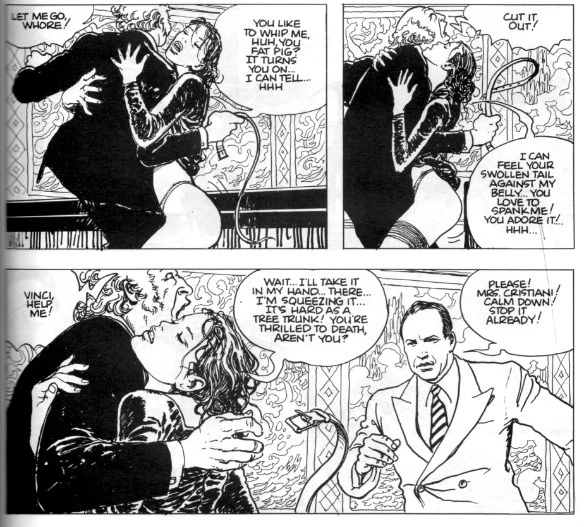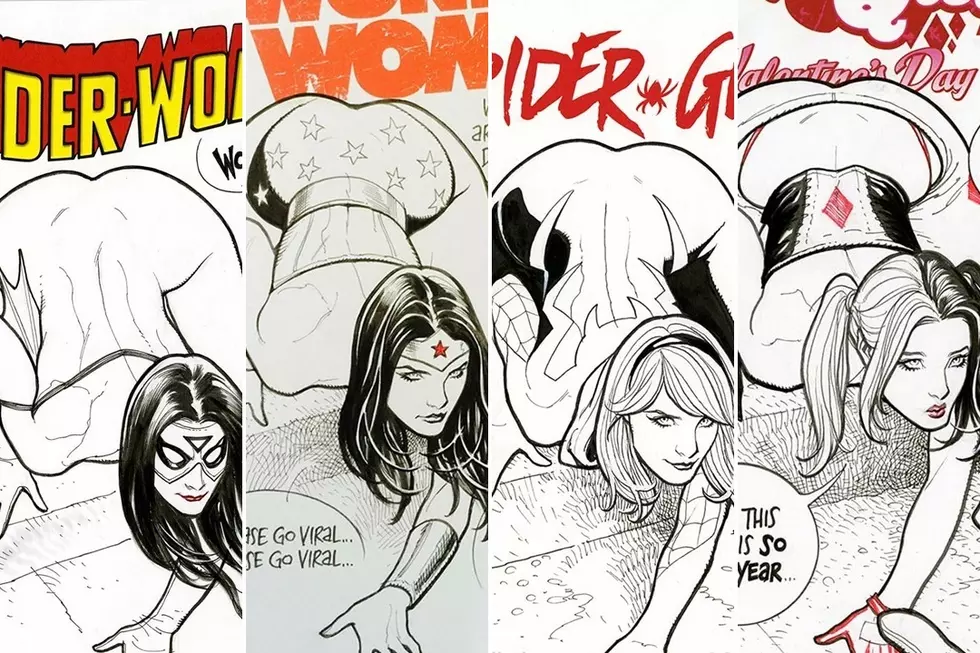![The Honesty of Exploitation: Sex in the Art of Milo Manara [Sex]](http://townsquare.media/site/622/files/2012/02/manara-2---exp.jpg?w=980&q=75)
The Honesty of Exploitation: Sex in the Art of Milo Manara [Sex]

In discussions about the great living cartoonists, the name Milo Manara is rarely bandied about, a state of affairs that is both impossible to believe and very easy to explain. Manara is a comics artist of uncommon ability, a master of linework and layout, whose storytelling chops deserve to be mentioned in the same breath as those of Kirby, Crumb, Toth, Moebius, or anyone else you'd put in that same grouping. He also happens to specialize in pornography in which women are sexually dominated and abused for the titillation of the reader. Our erotic comics fortnight rolls on, gentle Comics Alliance readers, so let's get sexy. Let's get problematically sexy.First, let me show you what I mean when I say Manara is a great comics artist. Just look at this two-page spread from the recent Dark Horse deluxe reprint of Indian Summer, by Manara and writer Hugo Pratt (click to enlarge):
Notice the way subjects and shapes echo across the two pages to move the characters and the reader through space and time. The receding fire on the first page gives way to the rising moon on the second, which then prompts a move back towards the fire. The boy in close-up on the far left runs so far and fast that he becomes a small figure in the distance on the far right. The three instances of the moon on the right hand page create a triangle, pointing us towards the center of the composition. The placement of the boy in relation to the moon gives us a sense of place that carries over into the fifth panel, with the moon behind nehind. Manara's art achieves all this and more -- and this is only an exposition scene!
Of course, it's the non-expositionary moments that get us into trouble.

The above is a bit from the inciting incident of Indian Summer, the rape of a Connecticut settler by two Connecticut Indians. Most of the scene looks like this: a clothed struggle which ends behind a sand-dune, with the actual rape obscured from view. But just at the end of the struggle, the dress comes up and the undergarments come off, and the reader is given a clear view of the woman's naked bottom half, rendered in Manara's trademark sensual line. The resulting sexiness of the abominably violent scene is, at the very least, uncomfortable. And this discomfort sets the tone for much of the book to follow.
Indian Summer is a meticulously researched historical drama of Puritan New England, and claims to tell the true story that inspired Nathaniel Hawthorne's The Scarlet Letter. (This claim might be a purposeful flight of fancy, or it might be legitimate. I couldn't confirm it, and I'm not smart enough to know if I should know that it's not serious. Either way, and for whichever reason, the text of the story purports this.) As such, though Indian Summer is a historical drama and not one of Manara's outright pornographies, the story is very much concerned with illicit sexual behavior going on under the noses of the repressed Puritan society.

There are two extended sequences devoted to men of the cloth secretly abusing young female charges, and these acts, while described as abominable by the text, are depicted with a heavy dose of erotic allure. Eroticism spreads from those two anchor points to suffuse the book, so that even non-sexual scenes are given heavy sexual undertones, just from the way Manara draws his women. What to make of a book, then, that trades so heavily in sexiness but whose only sex scenes are of rape and abuse?
It's tempting to throw the baby out with the bathwater, and dismiss the book as unreconstructed misogyny. Why should I treat Indian Summer's weird sexual politics any differently than those on display in that Titans book about Starfire wanting to bone dudes, or that New Avengers comic where Tigra got to star in a sexualized scene where she is beaten on film? Can I really just get out of this jam by pointing to the formal mastery of the work, the historical verisimilitude of the writing, or the highfalutin' European/Artcomix pedigree of the whole work?

Well, partially, yeah. But there's also something going on in Manara's eroticized violence that isn't reflected in the kind of sexualized nonsense that's rightfully called out by a lot of people, particularly around here. There is an upfrontness to the eroticism in Indian Summer that borders on confrontational with the reader. It demands recognition, and it demands an effort of reading that the casual sexism of mainstream comics does not.
Manara's erotic imagery implicates the reader in the abominable acts on display through arousal (a sufficiently sensual depiction of a naked woman can excite either sex) and the combination of arousal and revulsion forces the reader to leave behind simplistic moral judgments and engage critically with the text, with questions such as: Why is this arousing when it is also abhorrent? Is it okay to be aroused by fictionalized sexual violence? Is a denial of this arousal moral, or complicit with the repression of the Puritan minister in the story, who claims to despise all sexual impulses yet acts on all of his basest whims?
Manara's art is able to complicate the reader's response for two reasons. The first is because the sexually explicit imagery he creates is transgressive enough to shock, as opposed to the merely suggestive sexual imagery which permeates mainstream comics (and mainstream culture at large). The fact of Manara's transgressiveness is proved by the fact that I can't actually show you any of the images in question on this blog due to their sexual content. But, of course, I can show you this:

The writer of the above scene (from New Avengers #35, 2007), Brian Michael Bendis, on the subject of any inherent titillation in a half-naked woman being beaten and videotaped, has been quoted as saying: "There wasn't anything sexual to it, except that her costume happens to be a bikini." Which is as tellingly oblivious a sentence as I think I could ever possibly read, but which also goes towards my point. That a costume might "happen to be a bikini," and be accepted uncritically, is a sign of the complete sublimation of sexual imagery. The sexual imagery is clearly there, yet can go unnoticed on a conscious level if one wishes to put blinders on.
Manara's explicit sexual imagery, in contrast, cannot be ignored as such. More importantly, Manara knows that it can't. And this is the second -- and more significant -- reason why Manara's erotic imagery is a successfully complex literary device: it's honest.
There is nothing ambiguous about the sensual charge of Manara's line. When he portrays a lascivious minister sexually abusing his niece, Manara's intent is upfront: He poses the niece nude, full-frontal to the audience nearly the entire time, and renders her with an achingly beautiful sexuality, even in her facial expressions. There is no attempt to hide the titillation factor of the scene, and there could never be any attempt to deny it.
 The New Avengers scene above operates on a juvenile level above the surface but a strenuously-denied exploitative level below the surface, such that any attempted discussion of the sexual content of the scene to first pass the hurdle of preposterous argument over what constitutes sexual content. Manara places exploitation in center frame, for all to see, making sexuality not only an automatic but a necessary part of the conversation.
The New Avengers scene above operates on a juvenile level above the surface but a strenuously-denied exploitative level below the surface, such that any attempted discussion of the sexual content of the scene to first pass the hurdle of preposterous argument over what constitutes sexual content. Manara places exploitation in center frame, for all to see, making sexuality not only an automatic but a necessary part of the conversation.
This is not to say that Manara's eroticism is completely un-problematic -- far from it. But through the honesty of his titillation, Manara invites discussion, rather than discouraging or avoiding it, and that makes a world of difference. Truly, who could look at X-Women, a comic by renowned pervert Chris Claremont and world-class pornographer Milo Manara, and not be automatically assured that the honest intent of the book is to get readers all hot and bothered?
The great bulk of Manara's work is dominated by the sexual adventures and misadventures of young women in various states of undress and consent. In a strange way, the more explicitly pornographic Manara's work becomes, the less morally problematic it seems. After all, he's explicitly drawing sexual fantasies to turn people on, and little anyone can do to control what sets their blood pumping. There's both a big and important gulf between sexual fantasy and reality; why not have an honest understanding between creator and reader as to what this is all for, and then have at it? And even in work devoted to being naughty, Manara cannot resist confronting the reader with complexity. Take this sequence from 1992's Click 2 (the majority of panels from which I can't even show you a little bit), in which an uncle has been whipping his niece in a rage over her public displays of lewd behavior.

By having the niece turn the tables on the uncle and confront him with his own deviant arousal, Manara once again forces a conversation with the reader over the uncomfortable confluence of desire and violence. The palpable fear in the uncle's expression in the last panel is the reader's fear. Both the uncle and the reader are shocked and appalled at their own sexual arousal, and yet for both it is a fact that must be reckoned with. The uncle reckons his with further violence. It seems inescapable that Manara is holding him up as a bad example, and urging the reader to reckon with acceptance, and to find a safe release in his dirty pictures.
Through his bracingly bawdy art, Manara argues that when it comes to desire, honesty really is the best policy; that if through fiction we can embrace our arousal, it'll all come out right in the end.

More From ComicsAlliance










